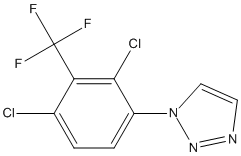ARUK3001185
Inhibitor of Notum. Compound 8l in Willis et al.2022 Compound 7d in Zhao et al. 2022 IC50 Notum 6.7 +/- 1.6 nM EC50 110 nM
General
Type : Trifluoro,Triazol
Chemical_Nomenclature : 1-(2,4-Dichloro-3-(trifluoromethyl)phenyl)-1H-1,2,3-triazole
Canonical SMILES : C1=CC(=C(C(=C1N2C=CN=N2)Cl)C(F)(F)F)Cl
InChI : InChI=1S\/C9H4Cl2F3N3\/c10-5-1-2-6(17-4-3-15-16-17)8(11)7(5)9(12,13)14\/h1-4H
InChIKey : XVFXHCLMGYJAQI-UHFFFAOYSA-N
Other name(s) : Compound 7d,8l,SCHEMBL21792325
MW : 282.05
Formula : C9H4Cl2F3N3
CAS_number :
PubChem : 146438044
UniChem : XVFXHCLMGYJAQI-UHFFFAOYSA-N
IUPHAR :
Wikipedia :

Target
Families : ARUK3001185 ligand of proteins in family: Pectinacetylesterase-Notum
Stucture : 7PK3 Structure of the human Wnt deacylase Notum in complex with ARUK3001185
Protein : human-NOTUM
References (5)
| Title : Structural Analysis and Development of Notum Fragment Screening Hits - Zhao_2022_ACS.Chem.Neurosci_13_2060 |
| Author(s) : Zhao Y , Mahy W , Willis NJ , Woodward HL , Steadman D , Bayle ED , Atkinson BN , Sipthorp J , Vecchia L , Ruza RR , Harlos K , Jeganathan F , Constantinou S , Costa A , Kjaer S , Bictash M , Salinas PC , Whiting P , Vincent JP , Fish PV , Jones EY |
| Ref : ACS Chem Neurosci , 13 :2060 , 2022 |
| Abstract : Zhao_2022_ACS.Chem.Neurosci_13_2060 |
| ESTHER : Zhao_2022_ACS.Chem.Neurosci_13_2060 |
| PubMedSearch : Zhao_2022_ACS.Chem.Neurosci_13_2060 |
| PubMedID: 35731924 |
| Gene_locus related to this paper: human-NOTUM |
| Title : Design of a potent, selective and brain penetrant inhibitor of Wnt-deactivating enzyme Notum by optimization of a crystallographic fragment hit - Willis_2022_J.Med.Chem_65_7212 |
| Author(s) : Willis NJ , Mahy W , Sipthorp J , Zhao Y , Woodward HL , Atkinson BN , Bayle ED , Svensson F , Frew S , Jeganathan F , Monaghan A , Benvegnu S , Jolly S , Vecchia L , Ruza RR , Kjaer S , Howell SA , Snidjers AP , Bictash M , Salinas PC , Vincent JP , Jones EY , Whiting P , Fish PV |
| Ref : Journal of Medicinal Chemistry , 65 :7212 , 2022 |
| Abstract : Willis_2022_J.Med.Chem_65_7212 |
| ESTHER : Willis_2022_J.Med.Chem_65_7212 |
| PubMedSearch : Willis_2022_J.Med.Chem_65_7212 |
| PubMedID: 35536179 |
| Gene_locus related to this paper: human-NOTUM |
| Title : Small-molecule inhibitors of carboxylesterase Notum - Zhao_2021_Future.Med.Chem__ |
| Author(s) : Zhao Y , Jolly S , Benvegnu S , Jones EY , Fish PV |
| Ref : Future Med Chem , : , 2021 |
| Abstract : Zhao_2021_Future.Med.Chem__ |
| ESTHER : Zhao_2021_Future.Med.Chem__ |
| PubMedSearch : Zhao_2021_Future.Med.Chem__ |
| PubMedID: 33882714 |
| Gene_locus related to this paper: human-NOTUM |
| Title : Carboxylesterase Notum Is a Druggable Target to Modulate Wnt Signaling - Bayle_2021_J.Med.Chem__ |
| Author(s) : Bayle ED , Svensson F , Atkinson BN , Steadman D , Willis NJ , Woodward HL , Whiting P , Vincent JP , Fish PV |
| Ref : Journal of Medicinal Chemistry , : , 2021 |
| Abstract : Bayle_2021_J.Med.Chem__ |
| ESTHER : Bayle_2021_J.Med.Chem__ |
| PubMedSearch : Bayle_2021_J.Med.Chem__ |
| PubMedID: 33783220 |
| Gene_locus related to this paper: human-NOTUM |
| Title : 5-Phenyl-1,3,4-oxadiazol-2(3H)-ones Are Potent Inhibitors of Notum Carboxylesterase Activity Identified by the Optimization of a Crystallographic Fragment Screening Hit - Mahy_2020_J.Med.Chem_63_12942 |
| Author(s) : Mahy W , Willis NJ , Zhao Y , Woodward HL , Svensson F , Sipthorp J , Vecchia L , Ruza RR , Hillier J , Kjr S , Frew S , Monaghan A , Bictash M , Salinas PC , Whiting P , Vincent JP , Jones EY , Fish PV |
| Ref : Journal of Medicinal Chemistry , 63 :12942 , 2020 |
| Abstract : Mahy_2020_J.Med.Chem_63_12942 |
| ESTHER : Mahy_2020_J.Med.Chem_63_12942 |
| PubMedSearch : Mahy_2020_J.Med.Chem_63_12942 |
| PubMedID: 33124429 |
| Gene_locus related to this paper: human-NOTUM |